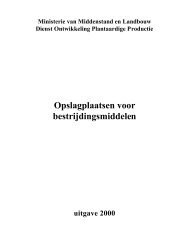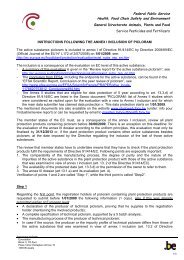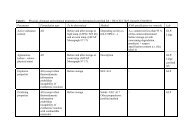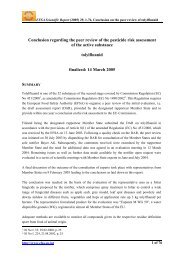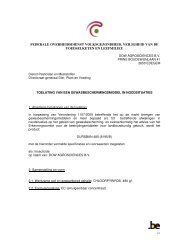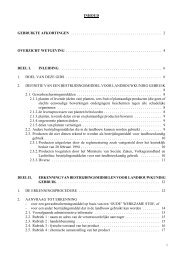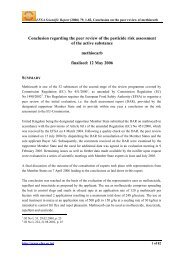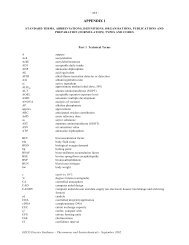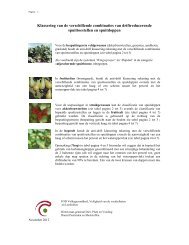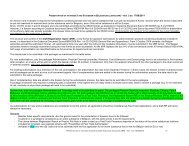Assessment of the Equivalence of Technical Materials - European ...
Assessment of the Equivalence of Technical Materials - European ...
Assessment of the Equivalence of Technical Materials - European ...
- No tags were found...
You also want an ePaper? Increase the reach of your titles
YUMPU automatically turns print PDFs into web optimized ePapers that Google loves.
Significant impuritiesImpurities that occur due to process variability 1 in quantities ≥ 1 g/kg in <strong>the</strong> active substanceas manufactured, based on dry weight, are regarded as significant.Relevant impuritiesAll impurities <strong>of</strong> toxicological and/or ecotoxicological or environmental concern 2 comparedwith <strong>the</strong> active substance, even if present in technical material at < 1 g/kg.6 Evaluation <strong>of</strong> equivalence <strong>of</strong> technical materials (Tier I)6.1 Data requirements1. <strong>Technical</strong> material coming from a new/different manufacturerThe data under points 1.1.-1.11 and 4.1 <strong>of</strong> Annex IIA <strong>of</strong> <strong>the</strong> Directive 91/414/EEC must beprovided.2. Large scale production vs. pilot scale production.The data under point 1.11 <strong>of</strong> Annex IIA <strong>of</strong> <strong>the</strong> Directive 91/414/EEC must be provided. Forpoints 1.1-1.10 a statement from <strong>the</strong> applicant is sufficient if <strong>the</strong>re are no changes.The data under point 4.1 are required if <strong>the</strong>re is a change to <strong>the</strong> impurity pr<strong>of</strong>ile or if newanalytical methods are used.3. Change in <strong>the</strong> manufacturing process, and/or manufacturing location, and/or addition <strong>of</strong>one or more alternative manufacturing locationsThe data under points 1.1.-1.11 <strong>of</strong> Annex IIA <strong>of</strong> <strong>the</strong> Directive 91/414/EEC must be provided.The data under point 4.1 are required if <strong>the</strong>re is a change to <strong>the</strong> impurity pr<strong>of</strong>ile or if newanalytical methods are used.6.2 Evaluation processFor <strong>the</strong> evaluation <strong>of</strong> equivalence <strong>of</strong> different sources against <strong>the</strong> reference source, <strong>the</strong>following criteria should be considered in <strong>the</strong> Tier I approach.The new source is deemed to be equivalent to <strong>the</strong> reference source if:• <strong>the</strong> certified minimum purity is not lower than that <strong>of</strong> <strong>the</strong> reference source (taking intoaccount <strong>the</strong> ratio <strong>of</strong> isomers, where appropriate),• no new impurities are present• <strong>the</strong> limits <strong>of</strong> relevant impurities, as certified for <strong>the</strong> reference source, are not increased and1 Significant impurities may be present as a direct result <strong>of</strong> <strong>the</strong> chemical syn<strong>the</strong>sis process/conditions employedor may be present as a result <strong>of</strong> cross contamination within <strong>the</strong> production cycle.2 Considering <strong>the</strong> Regulation, <strong>the</strong> following definition is proposed for relevant impurities: such substancesinclude, but are not limited to, substances meeting <strong>the</strong> criteria to be classified as hazardous in accordance withRegulation (EC) No. 1272/2008 [extract from Art. 3(4)] or <strong>the</strong> available information (e.g. (Q)SAR, genotoxicity)indicates that <strong>the</strong> impurity has a toxicological hazard. Relevant impurities have <strong>the</strong> inherent capacity to causeharmful/unacceptable effects within <strong>the</strong> meaning <strong>of</strong> Article 4(2) and (3). Compared to <strong>the</strong> active substance,relevant impurities show additional (or more severe) toxic properties (in <strong>the</strong> sense <strong>of</strong> <strong>the</strong> above given properties).5



